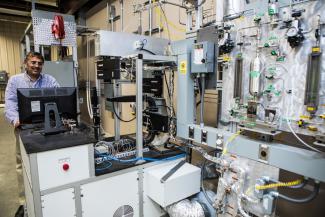NETL researchers are investigating the use of microwaves to convert a combination of waste plastics and the stalks, leaves and cobs that remain in fields after corn is harvested, called corn stover, into hydrogen, which can then be used in various industrial and energy-related applications.
The most common way of producing hydrogen fuel is natural gas steam reforming, which requires high temperatures so that steam reacts with the hydrocarbon fuel to produce hydrogen. The process is energy intensive and has a significant carbon footprint.
NETL researchers are pursuing microwave technology for application to a co-gasification process that uses waste plastic and corn stover as an effective way of producing hydrogen while reducing costs, the high volume of discarded plastic waste, and the carbon footprint prevalent in other hydrogen-producing processes.
Gasification can convert raw materials into gaseous fuels, but opportunities exist to reduce the energy intensity and operating costs to make it more attractive for broader market penetration.
The U.S. Department of Energy (DOE) defines gasification as “a technological process that can convert any carbonaceous (carbon-based) raw material into synthesis gas, or syngas. Gasification occurs in a gasifier, generally a high temperature/pressure vessel where oxygen (or air) and steam are directly contacted with the carbonaceous feed material causing a series of chemical reactions to occur that convert the feed to syngas.”
An NETL study notes that microwave heating can positively impact the gasification process.
Microwaves are a kind of electromagnetic radiation. They are used in point-to-point communication lines, wireless communications, microwave radio relaying networks, radar, satellites, spacecraft transmission, medical thermography, cancer therapy, and many other applications, including warming your coffee or making popcorn at home.
Microwaves can interact rapidly and directly with feedstocks in gasification processes. A microwave’s selective heating feature can reduce the bulk temperatures required to trigger the gasification reactions.
Another benefit of using microwaves is that they can enable a more compact gasifier design. Researchers noted that that microwave irradiation can effectively enhance gas-solid catalytic reactions.
However, because plastic in general is not a microwave-sensitive material, high power is still required to heat the plastic using a microwave reactor. That’s where corn stover comes in. The addition of biomass or other microwave-sensitive material can enhance plastic gasification rates by reducing the temperatures required for the gasification process.
“Taking such an advantage, we are able to explore the application of microwave technology for co-gasification of mixed plastic and corn stover as biomass,” the study authors reported.
The study concluded that “Microwave gasification had significantly higher syngas and hydrogen yields compared to conventional heating. Conventional runs produced higher tar than microwave gasification (31% vs. 9%). Due to selective heating of materials inside the microwave cavity – a benefit offered only within a microwave system, the difference in heating rates result in selective product distribution and enhanced reaction rates, providing synergistic effects of microwave heating on co-gasification of corn stover and plastics.”
The work could also lead to a reduction of plastic waste.
According to a study authored by a team of NETL researchers, the global plastic waste generation was approximately 353 million metric tons over the past two decades. Most of the plastic waste is landfilled or incinerated, and only 9% of plastic waste is recycled.
The NETL study was conducted by Ashraf Abedin, Xinwei Bai, Mark Smith, and Pranjali Muley.
NETL is a DOE national laboratory that drives innovation and delivers technological solutions for an environmentally sustainable and prosperous energy future. With its world-class talent and research facilities, NETL is ensuring affordable, abundant and reliable energy that drives a robust economy and national security, while developing technologies to manage carbon across the full life cycle, enabling environmental sustainability for all Americans.




